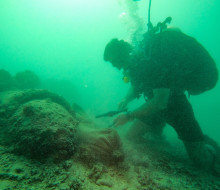
Second World War-era bombs in Vanuatu made safe by Navy divers
26 June 2024
Unfortunately you are viewing this website on an outdated browser which does not support the necessary features for us to provide an adequate experience. Please switch to a modern browser such as latest version of Google Chrome, Mozilla Firefox, Apple Safari or Microsoft Edge.
Ngā mihi nui
Parading the 28 (Maori) Battalion Banner at commemorations marking 80 years since the Battles of Cassino holds a lot of mana for New Zealand Army soldier Private Taedyn Edmonds-Griffiths.
The 21-year-old, from Great Barrier Island, is part of a New Zealand Defence Force (NZDF) contingent holding commemorative events in Italy next week, to remember those who fought and died in these gruelling Second World War battles.
In carrying out the duties of Banner Orderly, Private Edmonds-Griffiths (Ngāpuhi, Ngāti Kahungunu ki Wairarapa, and Te Āti Haunui-a-Pāpārangi) will honour more than 100 members of his family.
“I know that I whakapapa to more than 100 soldiers and other servicemen and women who served with the 28 (Maori) Battalion,” he said.
“I don't know all of their stories because I didn't grow up hearing them, as people didn’t talk about war when they got home. But because of their experiences I am free to pursue my own. I am here because my four-year-old self said this is what they saw in my future.”
Situated at the head of the Liri Valley, Cassino was a key point in the Gustav Line - a chain of German defences in the Italian mountains south of Rome. The battles to capture the town would ultimately open the pathway to the liberation of Rome and success in the Italian campaign.
But New Zealand’s efforts there through February and March 1944, proved to be among the most costly battles of the Second World War for the 2nd New Zealand Division - of the 1481 casualties, 343 lost their lives.
The first New Zealanders to fight there were the men of 28 (Maori) Battalion A and B Companies, who attacked along the Cassino Railway causeway.
The men advanced through a flooded field sown with mines and engaged in fierce hand-to-hand combat. As German forces launched a series of counter-attacks, the New Zealanders were forced to withdraw under heavy fire.
Of the 200 members of 28 (Maori) Battalion who fought there, more than 150 were killed, wounded or taken prisoner. The battle honour, MONASTERY HILL, was awarded to the battalion for these acts.
Next week, the NZDF contingent will support the New Zealand National Commemorative Service at the Cassino War Cemetery and a New Zealand Service of Remembrance at the Cassino Railway Station.
Private Edmonds-Griffiths said because of the connection to his whānau, he will bear the 28 (Maori) Battalion Banner with great honour and humility.
He said when his great-uncle Peter, whose father died during the Italian Campaign, found out about his Banner Orderly role, he had these kind words to say to Private Edmonds-Griffiths’ mum: “You must be a really proud parent and what an amazing experience for him to have. Thankfully, unlike many of our tāne, he will be coming home."
Warrant Officer Class 1 Matt Gates is the Regimental Sergeant Major for the New Zealand Army’s 2nd/1st Battalion, Royal New Zealand Infantry Regiment, and the Ceremonial Colour Officer for the NZDF contingent in Cassino.
He said this would be a momentous occasion for Private Edmonds-Griffiths and 2nd/1st Battalion.
“It’s an enormous honour and privilege to parade the banner and he’s representing both sides of his whānau that served in World War Two,” Warrant Officer Class 1 Gates said.
“Normally you’d need to be an officer to fulfil this duty, so to do this as a young soldier is very special. I think this will be one of the best things he’ll ever do.”
Along with the 28 (Maori) Battalion Banner, the Regimental Colour of 2nd/1st Battalion - which bears the Battle Honour CASSINO I - will be paraded at both services.